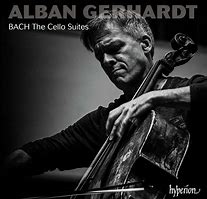Recently I attended an orchestra concert and heard cellist Alban Gerhardt performing a concerto composed especially for him by South Korean composer Unsuk Chin. It’s a sprawling, angular, technically demanding work that he nevertheless played from memory with apparent ease and command. Its piercing and insistent unisons and jarring harmonies were delivered with perfect intonation and dramatic intensity. It’s an acrobatic solo and impressive orchestral exercise with no hummable tunes for the soloist to lean on or for the audience to take away.
So I was intrigued to read Gerhardt’s bio in the concert program, mentioning his recent recording of Johann Sebastian Bach’s Six Suites for Unaccompanied Cello. (Hyperion CDA68261/2) Bach’s Suites are the “holy grail” for every serious cellist, and there are many (many!) recordings of them, so it’s no surprise that Gerhardt would want to tackle them, too. Legendary Hungarian cellist Janos Starker recorded them five times over the decades, and Yo-Yo Ma recently released his third recording of Bach’s Suites with the title SIX EVOLUTIONS, signifying how this music and the person playing it evolve over time. Here is where I confess that I am a tiny bit cynical about the steady stream of recordings of the Bach Suites from so many musicians. It is overwhelming, because this challenging and iconic music has already been recorded so magnificently by extraordinary musicians whose artistry has raised the bar for their presentation. And while I respect and admire musicians who follow their passion, and I understand why cellists are drawn to this music, I’m skeptical about whether their take on it adds something compelling and necessary to the field. Play it — of course! Record it — why?
So I was curious to hear how Alban Gerhardt’s performance of Bach would compare and contrast to the many stellar interpretations of Bach’s intricate and challenging suites. I was also curious to hear how his approach to playing music that is more than 270 years old would compare and contrast to his approach to playing music composed in 2008 with his specific artistry in mind.
It was good. VERY good. The individual movements of Bach’s Suites include dances such as gigues, bourrees, menuets, and courantes, and he imparts them with breezy, cheerful playfulness. The slower and more tender sections have a directness and honesty (and beautiful tone) without being overly sentimental. I also like the way it was recorded: intimate and clear, without being so close that every squeak and breath is magnified. I am so glad I had a chance to sample Gerhardt’s artistry in person, and equally glad to have discovered his multi-faceted talents for baroque music, too. This skeptic has softened her attitude a bit, and suggests you give them a listen, too!

What I truly appreciate in your post is your critical eye and ear…and candid appraisals.
Thank you! I liked this musician’s artistry a lot, and hope you will listen and see what you think!